NUR1202: Building Therapeutic Relationships: A Nursing Case Study
VerifiedAdded on 2023/06/07
|12
|3509
|50
Essay
AI Summary
This essay critically analyzes a nursing case study focusing on the importance of establishing and maintaining therapeutic relationships with indigenous patients, adhering to the Nursing and Midwifery Board of Australia (NMBA) guidelines. It explores the principles of person-centered care, the significance of cultural competence, and the ethical considerations of paternalism in healthcare. The registered nurse's actions are evaluated against the NMBA code of conduct, highlighting the necessity of patient involvement, respect for cultural values, and the potential consequences of neglecting these principles in nursing practice. The essay emphasizes the need for nurses to advocate for their patients' cultural rights and build trust to bridge the gap between indigenous and non-indigenous healthcare experiences.
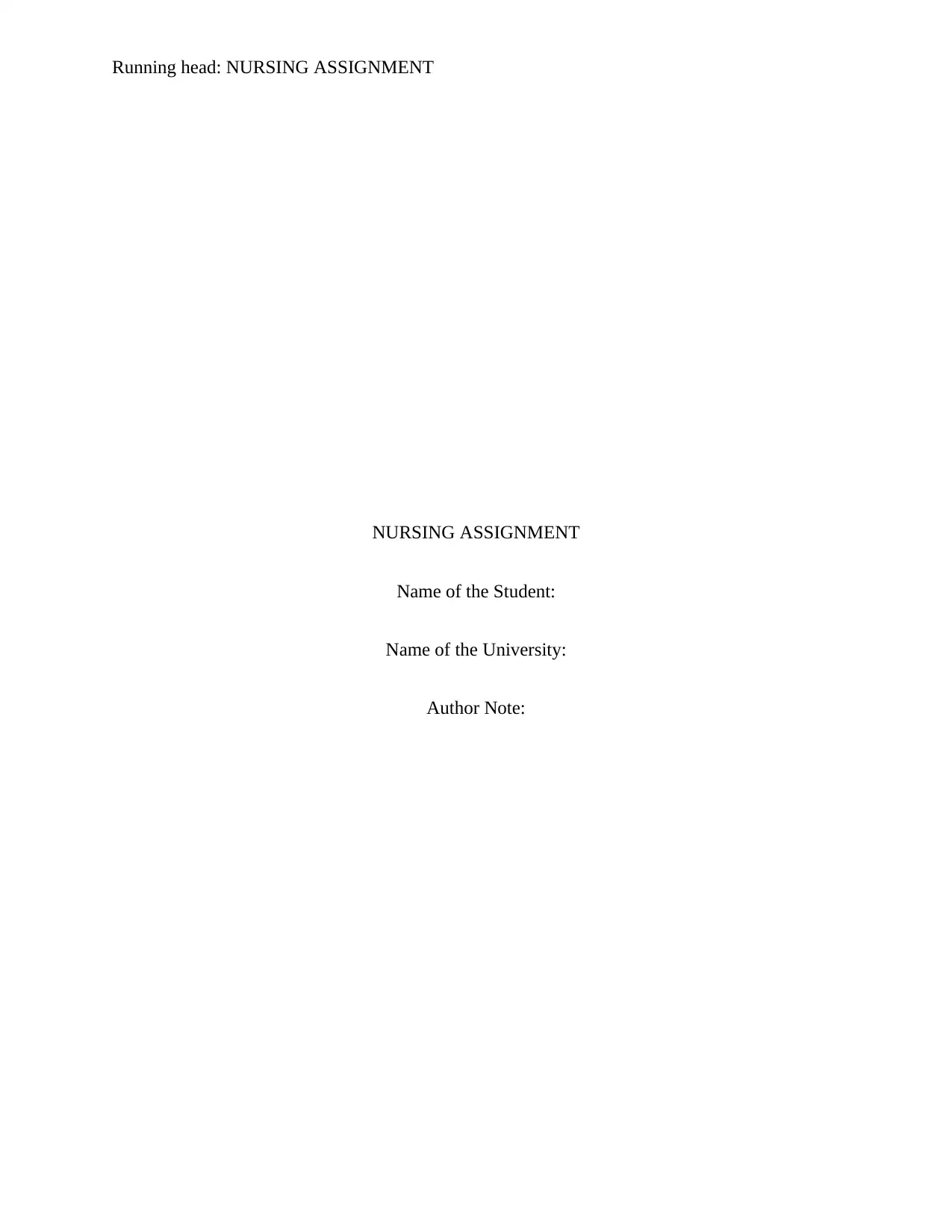
Running head: NURSING ASSIGNMENT
NURSING ASSIGNMENT
Name of the Student:
Name of the University:
Author Note:
NURSING ASSIGNMENT
Name of the Student:
Name of the University:
Author Note:
Paraphrase This Document
Need a fresh take? Get an instant paraphrase of this document with our AI Paraphraser
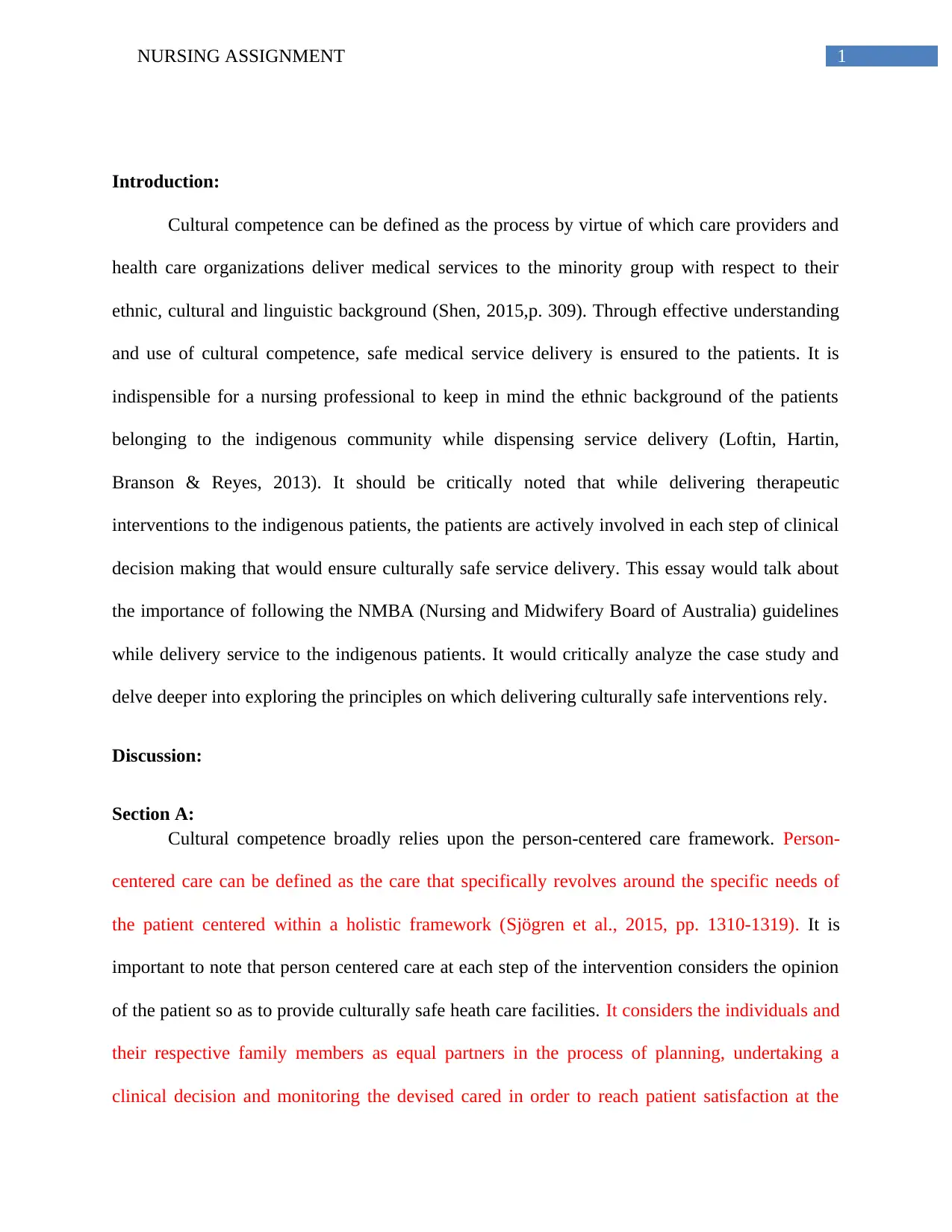
1NURSING ASSIGNMENT
Introduction:
Cultural competence can be defined as the process by virtue of which care providers and
health care organizations deliver medical services to the minority group with respect to their
ethnic, cultural and linguistic background (Shen, 2015,p. 309). Through effective understanding
and use of cultural competence, safe medical service delivery is ensured to the patients. It is
indispensible for a nursing professional to keep in mind the ethnic background of the patients
belonging to the indigenous community while dispensing service delivery (Loftin, Hartin,
Branson & Reyes, 2013). It should be critically noted that while delivering therapeutic
interventions to the indigenous patients, the patients are actively involved in each step of clinical
decision making that would ensure culturally safe service delivery. This essay would talk about
the importance of following the NMBA (Nursing and Midwifery Board of Australia) guidelines
while delivery service to the indigenous patients. It would critically analyze the case study and
delve deeper into exploring the principles on which delivering culturally safe interventions rely.
Discussion:
Section A:
Cultural competence broadly relies upon the person-centered care framework. Person-
centered care can be defined as the care that specifically revolves around the specific needs of
the patient centered within a holistic framework (Sjögren et al., 2015, pp. 1310-1319). It is
important to note that person centered care at each step of the intervention considers the opinion
of the patient so as to provide culturally safe heath care facilities. It considers the individuals and
their respective family members as equal partners in the process of planning, undertaking a
clinical decision and monitoring the devised cared in order to reach patient satisfaction at the
Introduction:
Cultural competence can be defined as the process by virtue of which care providers and
health care organizations deliver medical services to the minority group with respect to their
ethnic, cultural and linguistic background (Shen, 2015,p. 309). Through effective understanding
and use of cultural competence, safe medical service delivery is ensured to the patients. It is
indispensible for a nursing professional to keep in mind the ethnic background of the patients
belonging to the indigenous community while dispensing service delivery (Loftin, Hartin,
Branson & Reyes, 2013). It should be critically noted that while delivering therapeutic
interventions to the indigenous patients, the patients are actively involved in each step of clinical
decision making that would ensure culturally safe service delivery. This essay would talk about
the importance of following the NMBA (Nursing and Midwifery Board of Australia) guidelines
while delivery service to the indigenous patients. It would critically analyze the case study and
delve deeper into exploring the principles on which delivering culturally safe interventions rely.
Discussion:
Section A:
Cultural competence broadly relies upon the person-centered care framework. Person-
centered care can be defined as the care that specifically revolves around the specific needs of
the patient centered within a holistic framework (Sjögren et al., 2015, pp. 1310-1319). It is
important to note that person centered care at each step of the intervention considers the opinion
of the patient so as to provide culturally safe heath care facilities. It considers the individuals and
their respective family members as equal partners in the process of planning, undertaking a
clinical decision and monitoring the devised cared in order to reach patient satisfaction at the
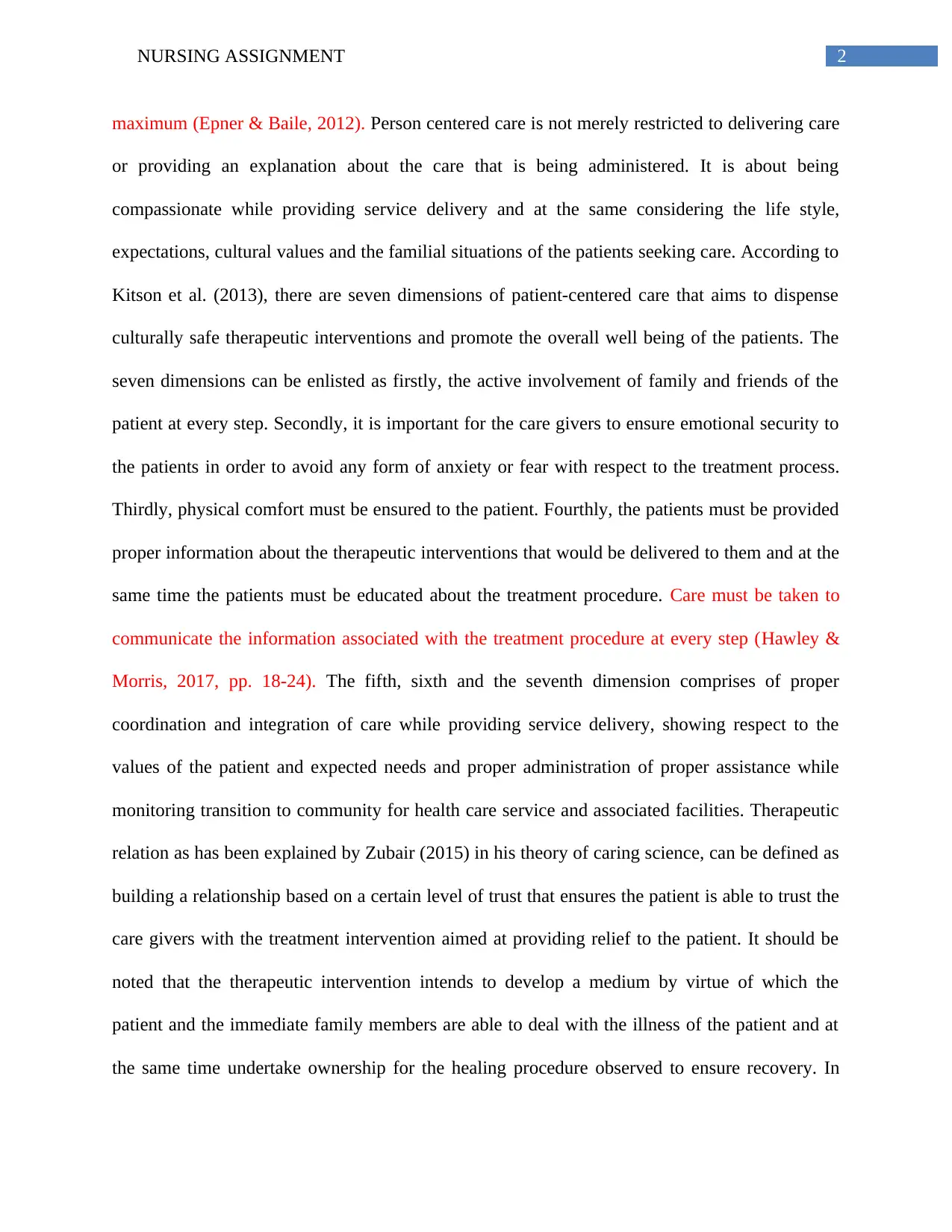
2NURSING ASSIGNMENT
maximum (Epner & Baile, 2012). Person centered care is not merely restricted to delivering care
or providing an explanation about the care that is being administered. It is about being
compassionate while providing service delivery and at the same considering the life style,
expectations, cultural values and the familial situations of the patients seeking care. According to
Kitson et al. (2013), there are seven dimensions of patient-centered care that aims to dispense
culturally safe therapeutic interventions and promote the overall well being of the patients. The
seven dimensions can be enlisted as firstly, the active involvement of family and friends of the
patient at every step. Secondly, it is important for the care givers to ensure emotional security to
the patients in order to avoid any form of anxiety or fear with respect to the treatment process.
Thirdly, physical comfort must be ensured to the patient. Fourthly, the patients must be provided
proper information about the therapeutic interventions that would be delivered to them and at the
same time the patients must be educated about the treatment procedure. Care must be taken to
communicate the information associated with the treatment procedure at every step (Hawley &
Morris, 2017, pp. 18-24). The fifth, sixth and the seventh dimension comprises of proper
coordination and integration of care while providing service delivery, showing respect to the
values of the patient and expected needs and proper administration of proper assistance while
monitoring transition to community for health care service and associated facilities. Therapeutic
relation as has been explained by Zubair (2015) in his theory of caring science, can be defined as
building a relationship based on a certain level of trust that ensures the patient is able to trust the
care givers with the treatment intervention aimed at providing relief to the patient. It should be
noted that the therapeutic intervention intends to develop a medium by virtue of which the
patient and the immediate family members are able to deal with the illness of the patient and at
the same time undertake ownership for the healing procedure observed to ensure recovery. In
maximum (Epner & Baile, 2012). Person centered care is not merely restricted to delivering care
or providing an explanation about the care that is being administered. It is about being
compassionate while providing service delivery and at the same considering the life style,
expectations, cultural values and the familial situations of the patients seeking care. According to
Kitson et al. (2013), there are seven dimensions of patient-centered care that aims to dispense
culturally safe therapeutic interventions and promote the overall well being of the patients. The
seven dimensions can be enlisted as firstly, the active involvement of family and friends of the
patient at every step. Secondly, it is important for the care givers to ensure emotional security to
the patients in order to avoid any form of anxiety or fear with respect to the treatment process.
Thirdly, physical comfort must be ensured to the patient. Fourthly, the patients must be provided
proper information about the therapeutic interventions that would be delivered to them and at the
same time the patients must be educated about the treatment procedure. Care must be taken to
communicate the information associated with the treatment procedure at every step (Hawley &
Morris, 2017, pp. 18-24). The fifth, sixth and the seventh dimension comprises of proper
coordination and integration of care while providing service delivery, showing respect to the
values of the patient and expected needs and proper administration of proper assistance while
monitoring transition to community for health care service and associated facilities. Therapeutic
relation as has been explained by Zubair (2015) in his theory of caring science, can be defined as
building a relationship based on a certain level of trust that ensures the patient is able to trust the
care givers with the treatment intervention aimed at providing relief to the patient. It should be
noted that the therapeutic intervention intends to develop a medium by virtue of which the
patient and the immediate family members are able to deal with the illness of the patient and at
the same time undertake ownership for the healing procedure observed to ensure recovery. In
⊘ This is a preview!⊘
Do you want full access?
Subscribe today to unlock all pages.

Trusted by 1+ million students worldwide
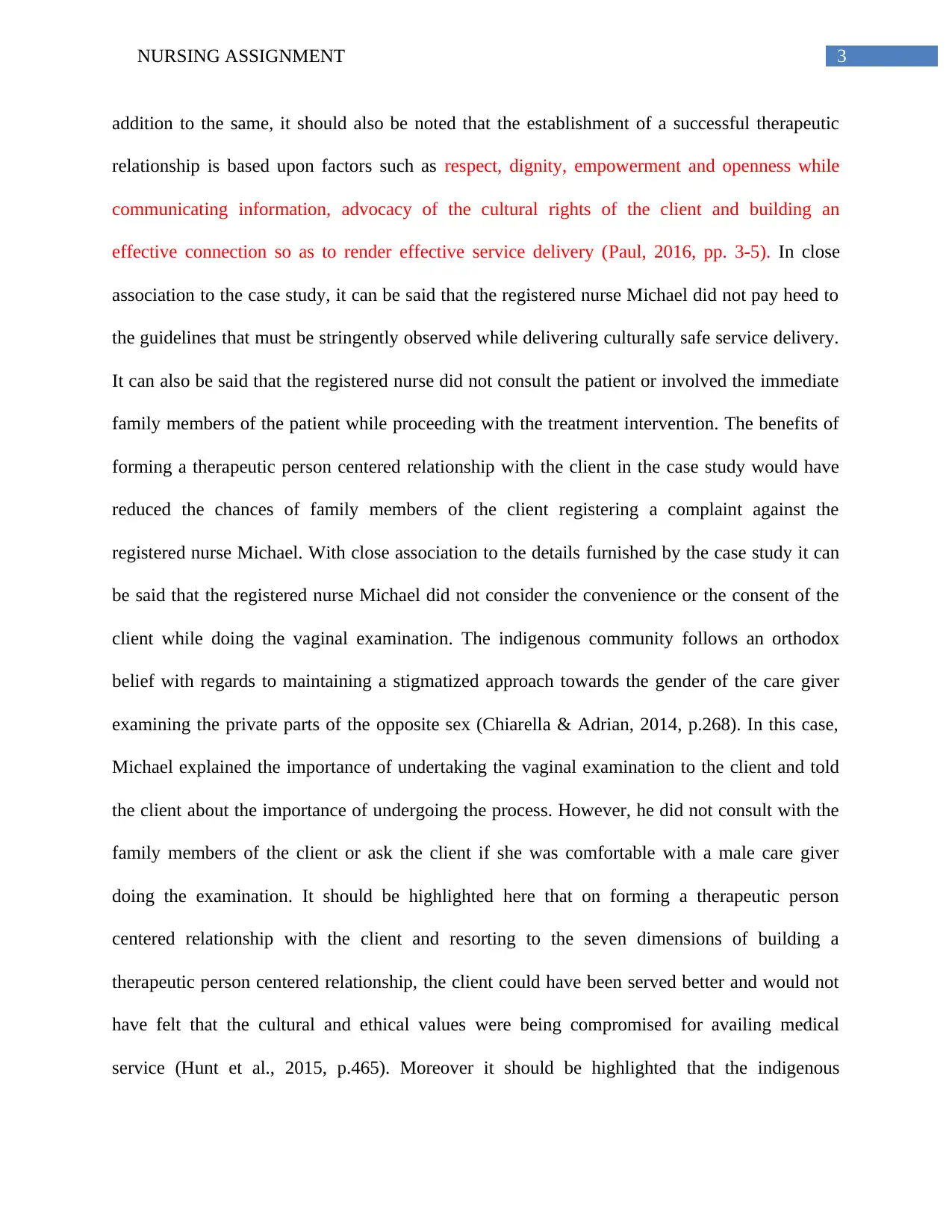
3NURSING ASSIGNMENT
addition to the same, it should also be noted that the establishment of a successful therapeutic
relationship is based upon factors such as respect, dignity, empowerment and openness while
communicating information, advocacy of the cultural rights of the client and building an
effective connection so as to render effective service delivery (Paul, 2016, pp. 3-5). In close
association to the case study, it can be said that the registered nurse Michael did not pay heed to
the guidelines that must be stringently observed while delivering culturally safe service delivery.
It can also be said that the registered nurse did not consult the patient or involved the immediate
family members of the patient while proceeding with the treatment intervention. The benefits of
forming a therapeutic person centered relationship with the client in the case study would have
reduced the chances of family members of the client registering a complaint against the
registered nurse Michael. With close association to the details furnished by the case study it can
be said that the registered nurse Michael did not consider the convenience or the consent of the
client while doing the vaginal examination. The indigenous community follows an orthodox
belief with regards to maintaining a stigmatized approach towards the gender of the care giver
examining the private parts of the opposite sex (Chiarella & Adrian, 2014, p.268). In this case,
Michael explained the importance of undertaking the vaginal examination to the client and told
the client about the importance of undergoing the process. However, he did not consult with the
family members of the client or ask the client if she was comfortable with a male care giver
doing the examination. It should be highlighted here that on forming a therapeutic person
centered relationship with the client and resorting to the seven dimensions of building a
therapeutic person centered relationship, the client could have been served better and would not
have felt that the cultural and ethical values were being compromised for availing medical
service (Hunt et al., 2015, p.465). Moreover it should be highlighted that the indigenous
addition to the same, it should also be noted that the establishment of a successful therapeutic
relationship is based upon factors such as respect, dignity, empowerment and openness while
communicating information, advocacy of the cultural rights of the client and building an
effective connection so as to render effective service delivery (Paul, 2016, pp. 3-5). In close
association to the case study, it can be said that the registered nurse Michael did not pay heed to
the guidelines that must be stringently observed while delivering culturally safe service delivery.
It can also be said that the registered nurse did not consult the patient or involved the immediate
family members of the patient while proceeding with the treatment intervention. The benefits of
forming a therapeutic person centered relationship with the client in the case study would have
reduced the chances of family members of the client registering a complaint against the
registered nurse Michael. With close association to the details furnished by the case study it can
be said that the registered nurse Michael did not consider the convenience or the consent of the
client while doing the vaginal examination. The indigenous community follows an orthodox
belief with regards to maintaining a stigmatized approach towards the gender of the care giver
examining the private parts of the opposite sex (Chiarella & Adrian, 2014, p.268). In this case,
Michael explained the importance of undertaking the vaginal examination to the client and told
the client about the importance of undergoing the process. However, he did not consult with the
family members of the client or ask the client if she was comfortable with a male care giver
doing the examination. It should be highlighted here that on forming a therapeutic person
centered relationship with the client and resorting to the seven dimensions of building a
therapeutic person centered relationship, the client could have been served better and would not
have felt that the cultural and ethical values were being compromised for availing medical
service (Hunt et al., 2015, p.465). Moreover it should be highlighted that the indigenous
Paraphrase This Document
Need a fresh take? Get an instant paraphrase of this document with our AI Paraphraser
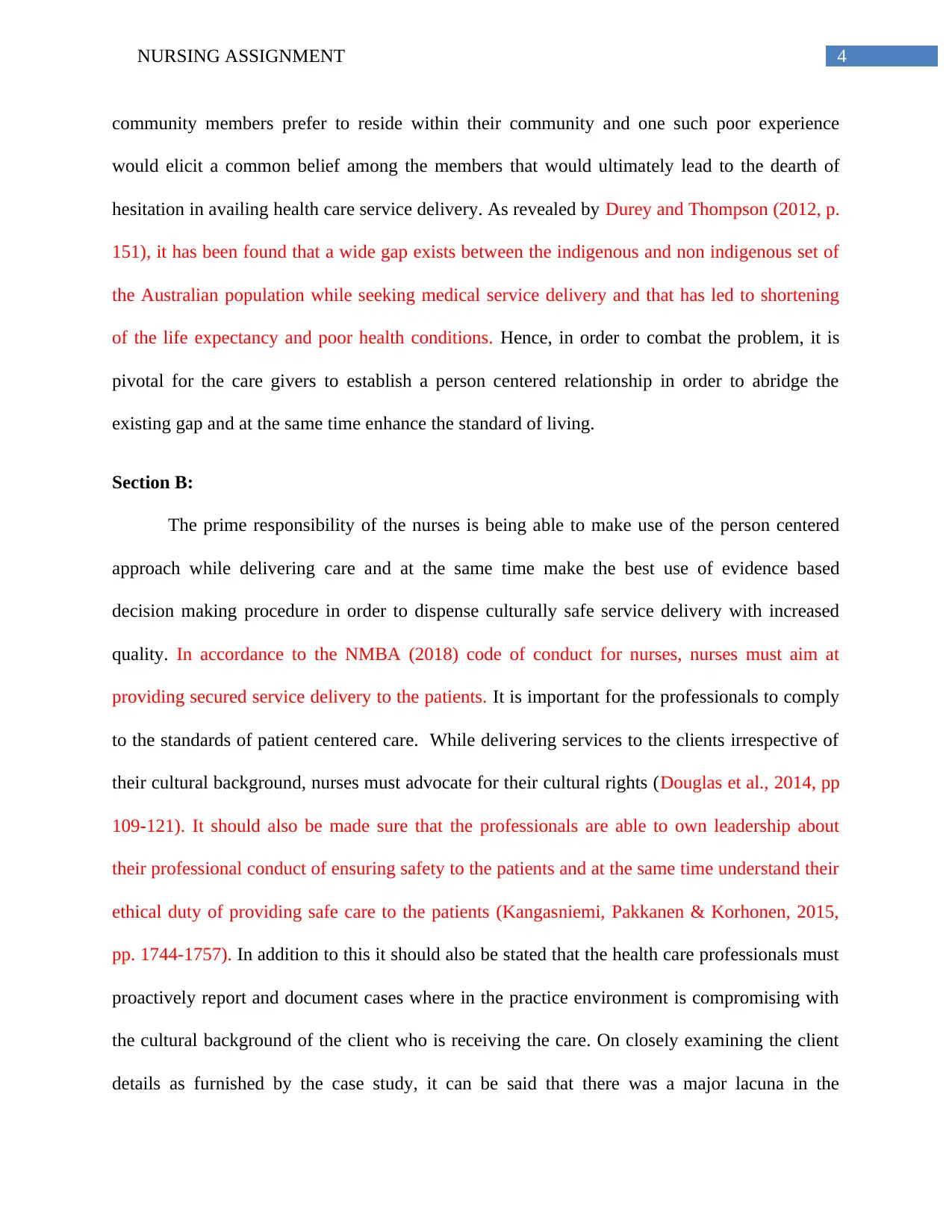
4NURSING ASSIGNMENT
community members prefer to reside within their community and one such poor experience
would elicit a common belief among the members that would ultimately lead to the dearth of
hesitation in availing health care service delivery. As revealed by Durey and Thompson (2012, p.
151), it has been found that a wide gap exists between the indigenous and non indigenous set of
the Australian population while seeking medical service delivery and that has led to shortening
of the life expectancy and poor health conditions. Hence, in order to combat the problem, it is
pivotal for the care givers to establish a person centered relationship in order to abridge the
existing gap and at the same time enhance the standard of living.
Section B:
The prime responsibility of the nurses is being able to make use of the person centered
approach while delivering care and at the same time make the best use of evidence based
decision making procedure in order to dispense culturally safe service delivery with increased
quality. In accordance to the NMBA (2018) code of conduct for nurses, nurses must aim at
providing secured service delivery to the patients. It is important for the professionals to comply
to the standards of patient centered care. While delivering services to the clients irrespective of
their cultural background, nurses must advocate for their cultural rights (Douglas et al., 2014, pp
109-121). It should also be made sure that the professionals are able to own leadership about
their professional conduct of ensuring safety to the patients and at the same time understand their
ethical duty of providing safe care to the patients (Kangasniemi, Pakkanen & Korhonen, 2015,
pp. 1744-1757). In addition to this it should also be stated that the health care professionals must
proactively report and document cases where in the practice environment is compromising with
the cultural background of the client who is receiving the care. On closely examining the client
details as furnished by the case study, it can be said that there was a major lacuna in the
community members prefer to reside within their community and one such poor experience
would elicit a common belief among the members that would ultimately lead to the dearth of
hesitation in availing health care service delivery. As revealed by Durey and Thompson (2012, p.
151), it has been found that a wide gap exists between the indigenous and non indigenous set of
the Australian population while seeking medical service delivery and that has led to shortening
of the life expectancy and poor health conditions. Hence, in order to combat the problem, it is
pivotal for the care givers to establish a person centered relationship in order to abridge the
existing gap and at the same time enhance the standard of living.
Section B:
The prime responsibility of the nurses is being able to make use of the person centered
approach while delivering care and at the same time make the best use of evidence based
decision making procedure in order to dispense culturally safe service delivery with increased
quality. In accordance to the NMBA (2018) code of conduct for nurses, nurses must aim at
providing secured service delivery to the patients. It is important for the professionals to comply
to the standards of patient centered care. While delivering services to the clients irrespective of
their cultural background, nurses must advocate for their cultural rights (Douglas et al., 2014, pp
109-121). It should also be made sure that the professionals are able to own leadership about
their professional conduct of ensuring safety to the patients and at the same time understand their
ethical duty of providing safe care to the patients (Kangasniemi, Pakkanen & Korhonen, 2015,
pp. 1744-1757). In addition to this it should also be stated that the health care professionals must
proactively report and document cases where in the practice environment is compromising with
the cultural background of the client who is receiving the care. On closely examining the client
details as furnished by the case study, it can be said that there was a major lacuna in the
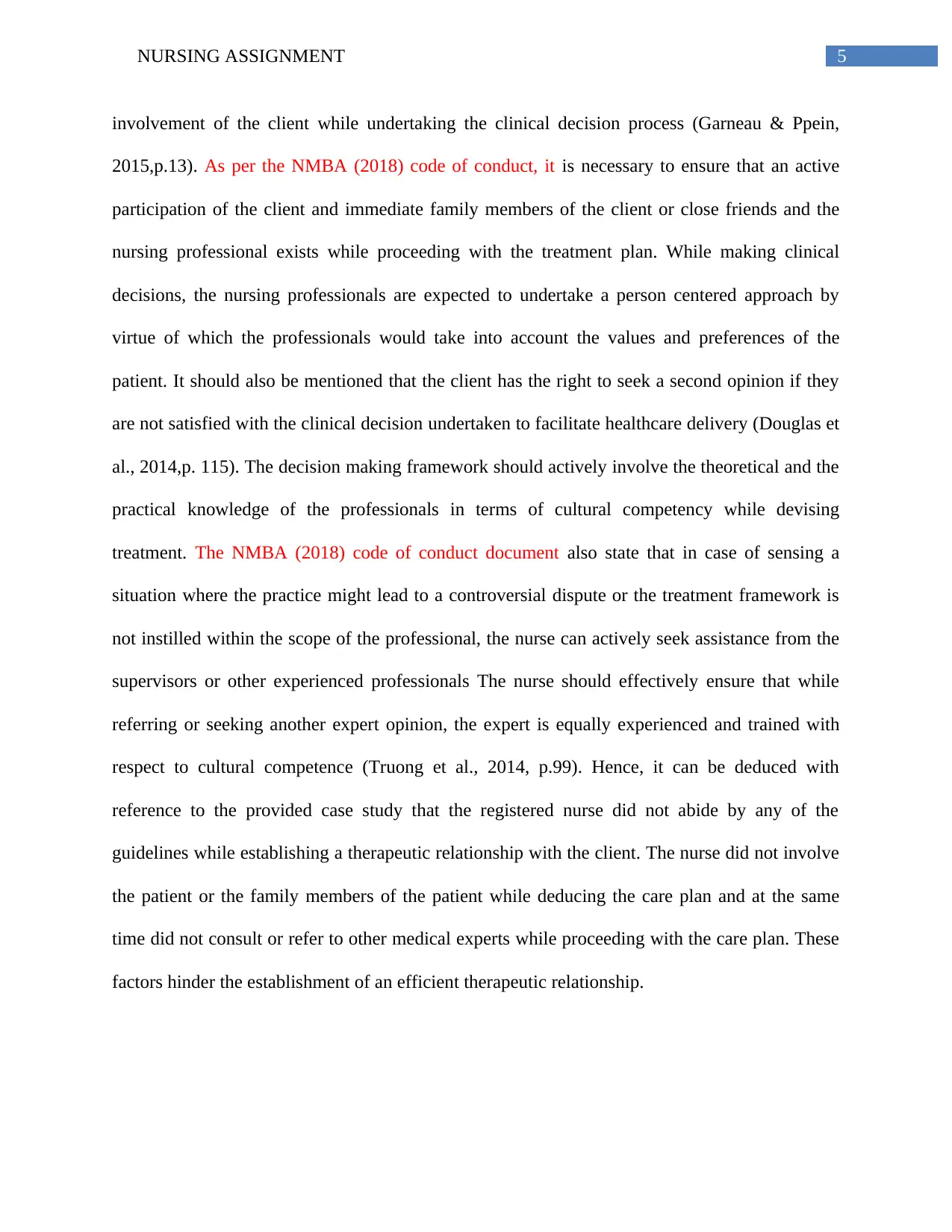
5NURSING ASSIGNMENT
involvement of the client while undertaking the clinical decision process (Garneau & Ppein,
2015,p.13). As per the NMBA (2018) code of conduct, it is necessary to ensure that an active
participation of the client and immediate family members of the client or close friends and the
nursing professional exists while proceeding with the treatment plan. While making clinical
decisions, the nursing professionals are expected to undertake a person centered approach by
virtue of which the professionals would take into account the values and preferences of the
patient. It should also be mentioned that the client has the right to seek a second opinion if they
are not satisfied with the clinical decision undertaken to facilitate healthcare delivery (Douglas et
al., 2014,p. 115). The decision making framework should actively involve the theoretical and the
practical knowledge of the professionals in terms of cultural competency while devising
treatment. The NMBA (2018) code of conduct document also state that in case of sensing a
situation where the practice might lead to a controversial dispute or the treatment framework is
not instilled within the scope of the professional, the nurse can actively seek assistance from the
supervisors or other experienced professionals The nurse should effectively ensure that while
referring or seeking another expert opinion, the expert is equally experienced and trained with
respect to cultural competence (Truong et al., 2014, p.99). Hence, it can be deduced with
reference to the provided case study that the registered nurse did not abide by any of the
guidelines while establishing a therapeutic relationship with the client. The nurse did not involve
the patient or the family members of the patient while deducing the care plan and at the same
time did not consult or refer to other medical experts while proceeding with the care plan. These
factors hinder the establishment of an efficient therapeutic relationship.
involvement of the client while undertaking the clinical decision process (Garneau & Ppein,
2015,p.13). As per the NMBA (2018) code of conduct, it is necessary to ensure that an active
participation of the client and immediate family members of the client or close friends and the
nursing professional exists while proceeding with the treatment plan. While making clinical
decisions, the nursing professionals are expected to undertake a person centered approach by
virtue of which the professionals would take into account the values and preferences of the
patient. It should also be mentioned that the client has the right to seek a second opinion if they
are not satisfied with the clinical decision undertaken to facilitate healthcare delivery (Douglas et
al., 2014,p. 115). The decision making framework should actively involve the theoretical and the
practical knowledge of the professionals in terms of cultural competency while devising
treatment. The NMBA (2018) code of conduct document also state that in case of sensing a
situation where the practice might lead to a controversial dispute or the treatment framework is
not instilled within the scope of the professional, the nurse can actively seek assistance from the
supervisors or other experienced professionals The nurse should effectively ensure that while
referring or seeking another expert opinion, the expert is equally experienced and trained with
respect to cultural competence (Truong et al., 2014, p.99). Hence, it can be deduced with
reference to the provided case study that the registered nurse did not abide by any of the
guidelines while establishing a therapeutic relationship with the client. The nurse did not involve
the patient or the family members of the patient while deducing the care plan and at the same
time did not consult or refer to other medical experts while proceeding with the care plan. These
factors hinder the establishment of an efficient therapeutic relationship.
⊘ This is a preview!⊘
Do you want full access?
Subscribe today to unlock all pages.

Trusted by 1+ million students worldwide
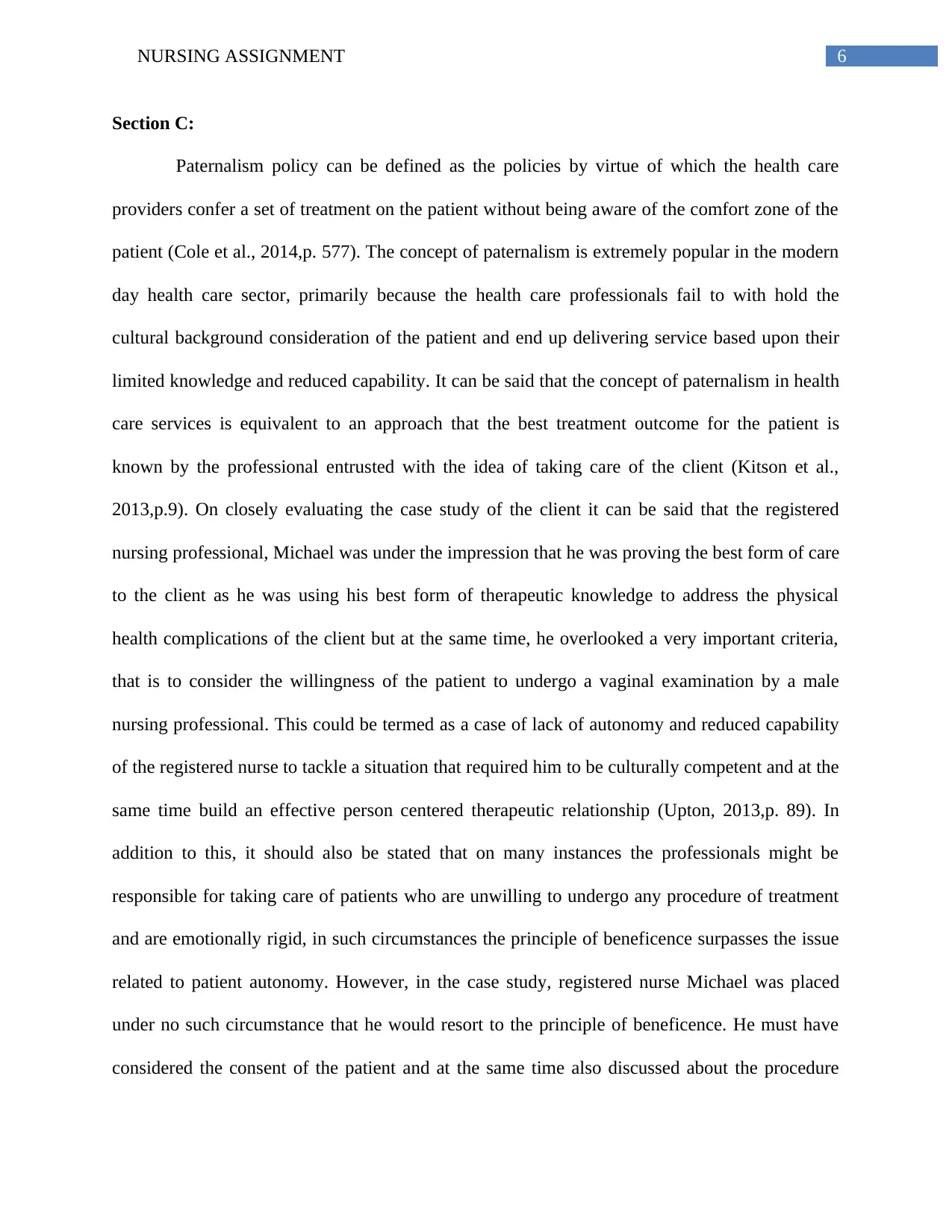
6NURSING ASSIGNMENT
Section C:
Paternalism policy can be defined as the policies by virtue of which the health care
providers confer a set of treatment on the patient without being aware of the comfort zone of the
patient (Cole et al., 2014,p. 577). The concept of paternalism is extremely popular in the modern
day health care sector, primarily because the health care professionals fail to with hold the
cultural background consideration of the patient and end up delivering service based upon their
limited knowledge and reduced capability. It can be said that the concept of paternalism in health
care services is equivalent to an approach that the best treatment outcome for the patient is
known by the professional entrusted with the idea of taking care of the client (Kitson et al.,
2013,p.9). On closely evaluating the case study of the client it can be said that the registered
nursing professional, Michael was under the impression that he was proving the best form of care
to the client as he was using his best form of therapeutic knowledge to address the physical
health complications of the client but at the same time, he overlooked a very important criteria,
that is to consider the willingness of the patient to undergo a vaginal examination by a male
nursing professional. This could be termed as a case of lack of autonomy and reduced capability
of the registered nurse to tackle a situation that required him to be culturally competent and at the
same time build an effective person centered therapeutic relationship (Upton, 2013,p. 89). In
addition to this, it should also be stated that on many instances the professionals might be
responsible for taking care of patients who are unwilling to undergo any procedure of treatment
and are emotionally rigid, in such circumstances the principle of beneficence surpasses the issue
related to patient autonomy. However, in the case study, registered nurse Michael was placed
under no such circumstance that he would resort to the principle of beneficence. He must have
considered the consent of the patient and at the same time also discussed about the procedure
Section C:
Paternalism policy can be defined as the policies by virtue of which the health care
providers confer a set of treatment on the patient without being aware of the comfort zone of the
patient (Cole et al., 2014,p. 577). The concept of paternalism is extremely popular in the modern
day health care sector, primarily because the health care professionals fail to with hold the
cultural background consideration of the patient and end up delivering service based upon their
limited knowledge and reduced capability. It can be said that the concept of paternalism in health
care services is equivalent to an approach that the best treatment outcome for the patient is
known by the professional entrusted with the idea of taking care of the client (Kitson et al.,
2013,p.9). On closely evaluating the case study of the client it can be said that the registered
nursing professional, Michael was under the impression that he was proving the best form of care
to the client as he was using his best form of therapeutic knowledge to address the physical
health complications of the client but at the same time, he overlooked a very important criteria,
that is to consider the willingness of the patient to undergo a vaginal examination by a male
nursing professional. This could be termed as a case of lack of autonomy and reduced capability
of the registered nurse to tackle a situation that required him to be culturally competent and at the
same time build an effective person centered therapeutic relationship (Upton, 2013,p. 89). In
addition to this, it should also be stated that on many instances the professionals might be
responsible for taking care of patients who are unwilling to undergo any procedure of treatment
and are emotionally rigid, in such circumstances the principle of beneficence surpasses the issue
related to patient autonomy. However, in the case study, registered nurse Michael was placed
under no such circumstance that he would resort to the principle of beneficence. He must have
considered the consent of the patient and at the same time also discussed about the procedure
Paraphrase This Document
Need a fresh take? Get an instant paraphrase of this document with our AI Paraphraser
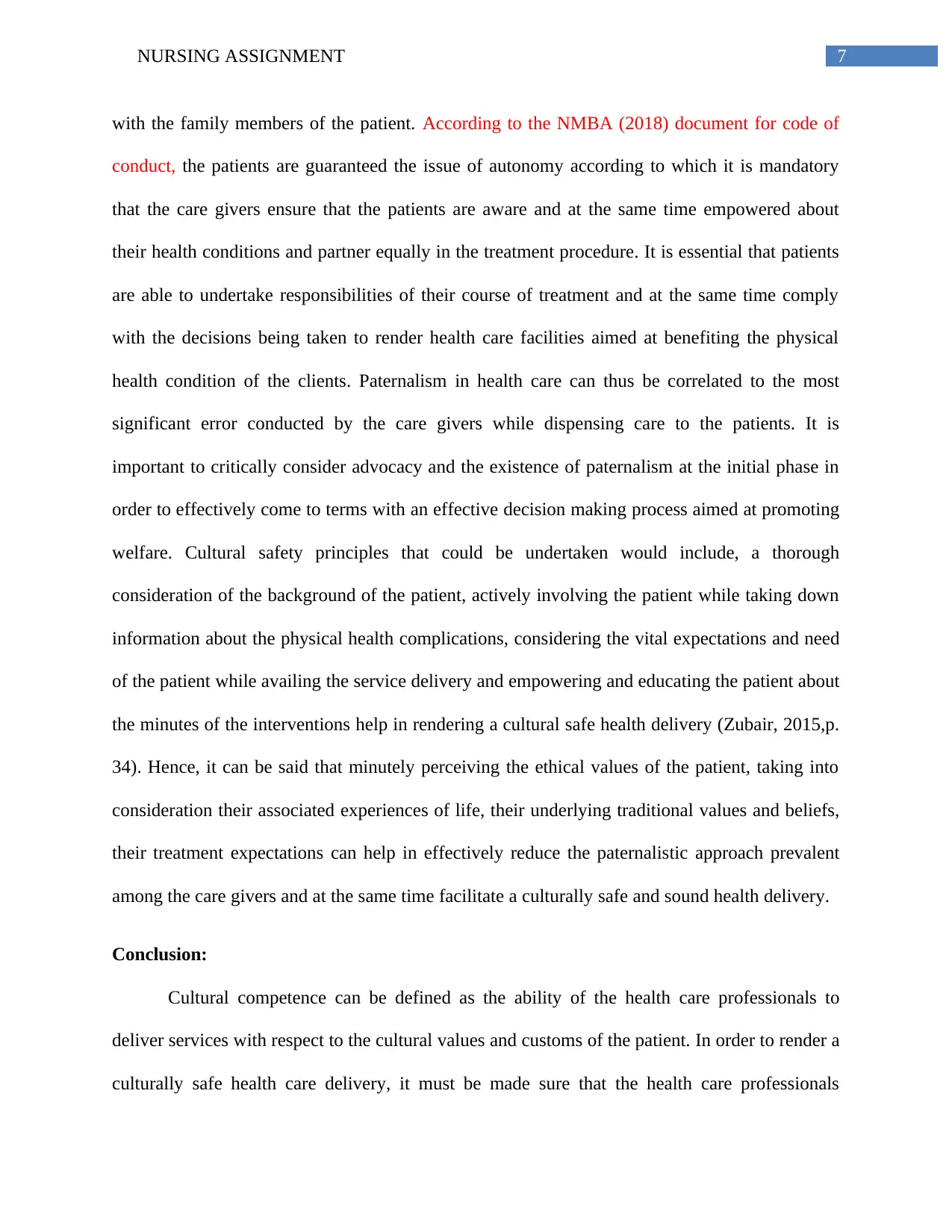
7NURSING ASSIGNMENT
with the family members of the patient. According to the NMBA (2018) document for code of
conduct, the patients are guaranteed the issue of autonomy according to which it is mandatory
that the care givers ensure that the patients are aware and at the same time empowered about
their health conditions and partner equally in the treatment procedure. It is essential that patients
are able to undertake responsibilities of their course of treatment and at the same time comply
with the decisions being taken to render health care facilities aimed at benefiting the physical
health condition of the clients. Paternalism in health care can thus be correlated to the most
significant error conducted by the care givers while dispensing care to the patients. It is
important to critically consider advocacy and the existence of paternalism at the initial phase in
order to effectively come to terms with an effective decision making process aimed at promoting
welfare. Cultural safety principles that could be undertaken would include, a thorough
consideration of the background of the patient, actively involving the patient while taking down
information about the physical health complications, considering the vital expectations and need
of the patient while availing the service delivery and empowering and educating the patient about
the minutes of the interventions help in rendering a cultural safe health delivery (Zubair, 2015,p.
34). Hence, it can be said that minutely perceiving the ethical values of the patient, taking into
consideration their associated experiences of life, their underlying traditional values and beliefs,
their treatment expectations can help in effectively reduce the paternalistic approach prevalent
among the care givers and at the same time facilitate a culturally safe and sound health delivery.
Conclusion:
Cultural competence can be defined as the ability of the health care professionals to
deliver services with respect to the cultural values and customs of the patient. In order to render a
culturally safe health care delivery, it must be made sure that the health care professionals
with the family members of the patient. According to the NMBA (2018) document for code of
conduct, the patients are guaranteed the issue of autonomy according to which it is mandatory
that the care givers ensure that the patients are aware and at the same time empowered about
their health conditions and partner equally in the treatment procedure. It is essential that patients
are able to undertake responsibilities of their course of treatment and at the same time comply
with the decisions being taken to render health care facilities aimed at benefiting the physical
health condition of the clients. Paternalism in health care can thus be correlated to the most
significant error conducted by the care givers while dispensing care to the patients. It is
important to critically consider advocacy and the existence of paternalism at the initial phase in
order to effectively come to terms with an effective decision making process aimed at promoting
welfare. Cultural safety principles that could be undertaken would include, a thorough
consideration of the background of the patient, actively involving the patient while taking down
information about the physical health complications, considering the vital expectations and need
of the patient while availing the service delivery and empowering and educating the patient about
the minutes of the interventions help in rendering a cultural safe health delivery (Zubair, 2015,p.
34). Hence, it can be said that minutely perceiving the ethical values of the patient, taking into
consideration their associated experiences of life, their underlying traditional values and beliefs,
their treatment expectations can help in effectively reduce the paternalistic approach prevalent
among the care givers and at the same time facilitate a culturally safe and sound health delivery.
Conclusion:
Cultural competence can be defined as the ability of the health care professionals to
deliver services with respect to the cultural values and customs of the patient. In order to render a
culturally safe health care delivery, it must be made sure that the health care professionals
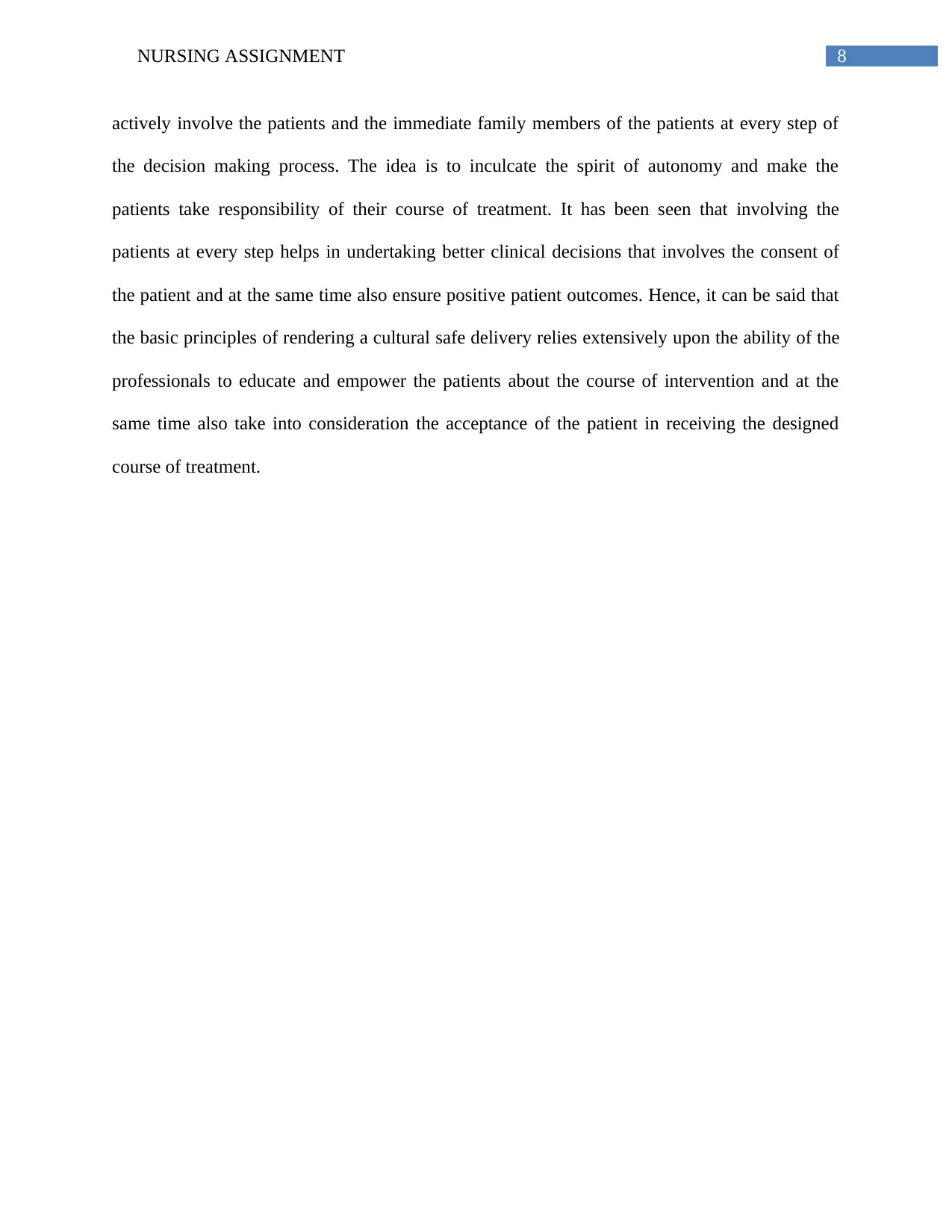
8NURSING ASSIGNMENT
actively involve the patients and the immediate family members of the patients at every step of
the decision making process. The idea is to inculcate the spirit of autonomy and make the
patients take responsibility of their course of treatment. It has been seen that involving the
patients at every step helps in undertaking better clinical decisions that involves the consent of
the patient and at the same time also ensure positive patient outcomes. Hence, it can be said that
the basic principles of rendering a cultural safe delivery relies extensively upon the ability of the
professionals to educate and empower the patients about the course of intervention and at the
same time also take into consideration the acceptance of the patient in receiving the designed
course of treatment.
actively involve the patients and the immediate family members of the patients at every step of
the decision making process. The idea is to inculcate the spirit of autonomy and make the
patients take responsibility of their course of treatment. It has been seen that involving the
patients at every step helps in undertaking better clinical decisions that involves the consent of
the patient and at the same time also ensure positive patient outcomes. Hence, it can be said that
the basic principles of rendering a cultural safe delivery relies extensively upon the ability of the
professionals to educate and empower the patients about the course of intervention and at the
same time also take into consideration the acceptance of the patient in receiving the designed
course of treatment.
⊘ This is a preview!⊘
Do you want full access?
Subscribe today to unlock all pages.

Trusted by 1+ million students worldwide
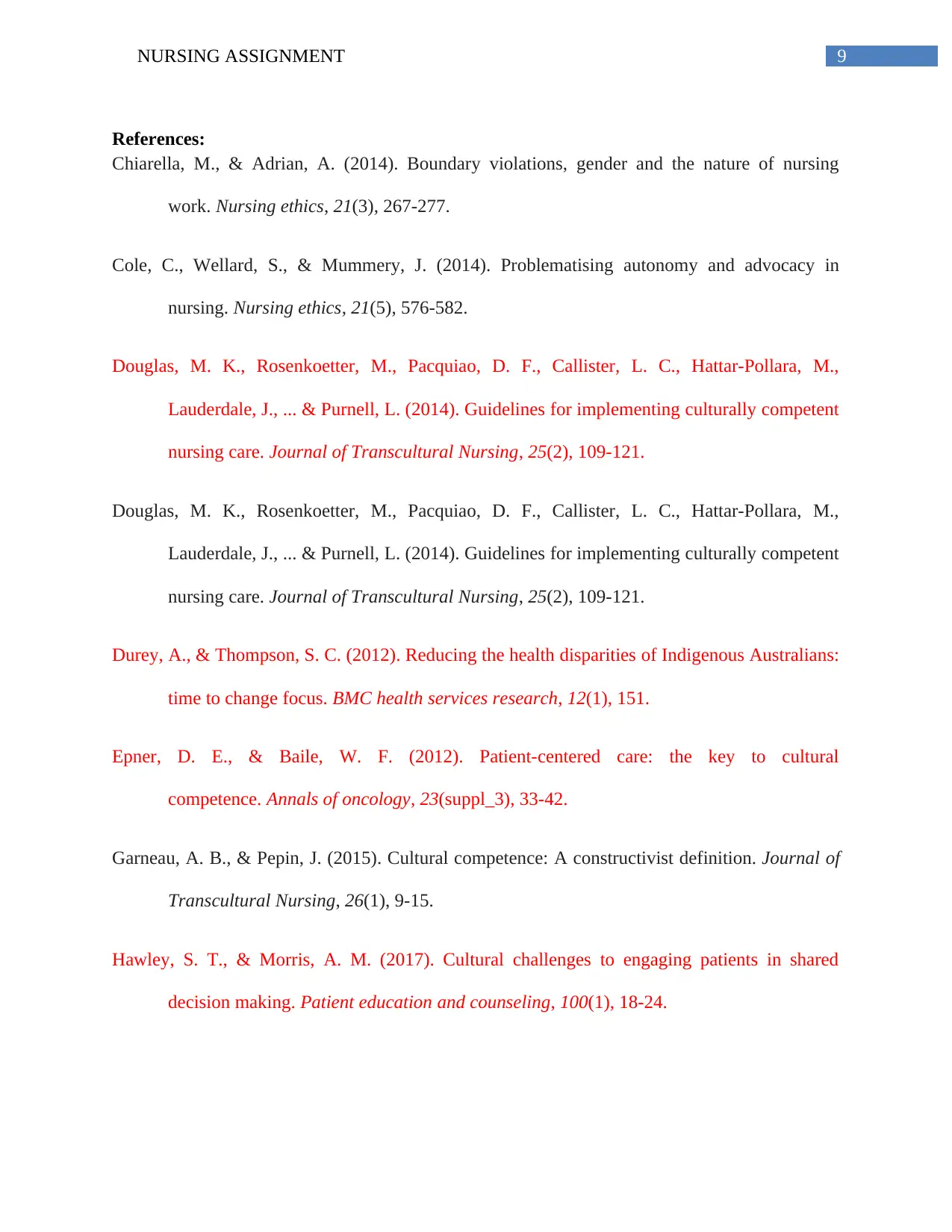
9NURSING ASSIGNMENT
References:
Chiarella, M., & Adrian, A. (2014). Boundary violations, gender and the nature of nursing
work. Nursing ethics, 21(3), 267-277.
Cole, C., Wellard, S., & Mummery, J. (2014). Problematising autonomy and advocacy in
nursing. Nursing ethics, 21(5), 576-582.
Douglas, M. K., Rosenkoetter, M., Pacquiao, D. F., Callister, L. C., Hattar-Pollara, M.,
Lauderdale, J., ... & Purnell, L. (2014). Guidelines for implementing culturally competent
nursing care. Journal of Transcultural Nursing, 25(2), 109-121.
Douglas, M. K., Rosenkoetter, M., Pacquiao, D. F., Callister, L. C., Hattar-Pollara, M.,
Lauderdale, J., ... & Purnell, L. (2014). Guidelines for implementing culturally competent
nursing care. Journal of Transcultural Nursing, 25(2), 109-121.
Durey, A., & Thompson, S. C. (2012). Reducing the health disparities of Indigenous Australians:
time to change focus. BMC health services research, 12(1), 151.
Epner, D. E., & Baile, W. F. (2012). Patient-centered care: the key to cultural
competence. Annals of oncology, 23(suppl_3), 33-42.
Garneau, A. B., & Pepin, J. (2015). Cultural competence: A constructivist definition. Journal of
Transcultural Nursing, 26(1), 9-15.
Hawley, S. T., & Morris, A. M. (2017). Cultural challenges to engaging patients in shared
decision making. Patient education and counseling, 100(1), 18-24.
References:
Chiarella, M., & Adrian, A. (2014). Boundary violations, gender and the nature of nursing
work. Nursing ethics, 21(3), 267-277.
Cole, C., Wellard, S., & Mummery, J. (2014). Problematising autonomy and advocacy in
nursing. Nursing ethics, 21(5), 576-582.
Douglas, M. K., Rosenkoetter, M., Pacquiao, D. F., Callister, L. C., Hattar-Pollara, M.,
Lauderdale, J., ... & Purnell, L. (2014). Guidelines for implementing culturally competent
nursing care. Journal of Transcultural Nursing, 25(2), 109-121.
Douglas, M. K., Rosenkoetter, M., Pacquiao, D. F., Callister, L. C., Hattar-Pollara, M.,
Lauderdale, J., ... & Purnell, L. (2014). Guidelines for implementing culturally competent
nursing care. Journal of Transcultural Nursing, 25(2), 109-121.
Durey, A., & Thompson, S. C. (2012). Reducing the health disparities of Indigenous Australians:
time to change focus. BMC health services research, 12(1), 151.
Epner, D. E., & Baile, W. F. (2012). Patient-centered care: the key to cultural
competence. Annals of oncology, 23(suppl_3), 33-42.
Garneau, A. B., & Pepin, J. (2015). Cultural competence: A constructivist definition. Journal of
Transcultural Nursing, 26(1), 9-15.
Hawley, S. T., & Morris, A. M. (2017). Cultural challenges to engaging patients in shared
decision making. Patient education and counseling, 100(1), 18-24.
Paraphrase This Document
Need a fresh take? Get an instant paraphrase of this document with our AI Paraphraser
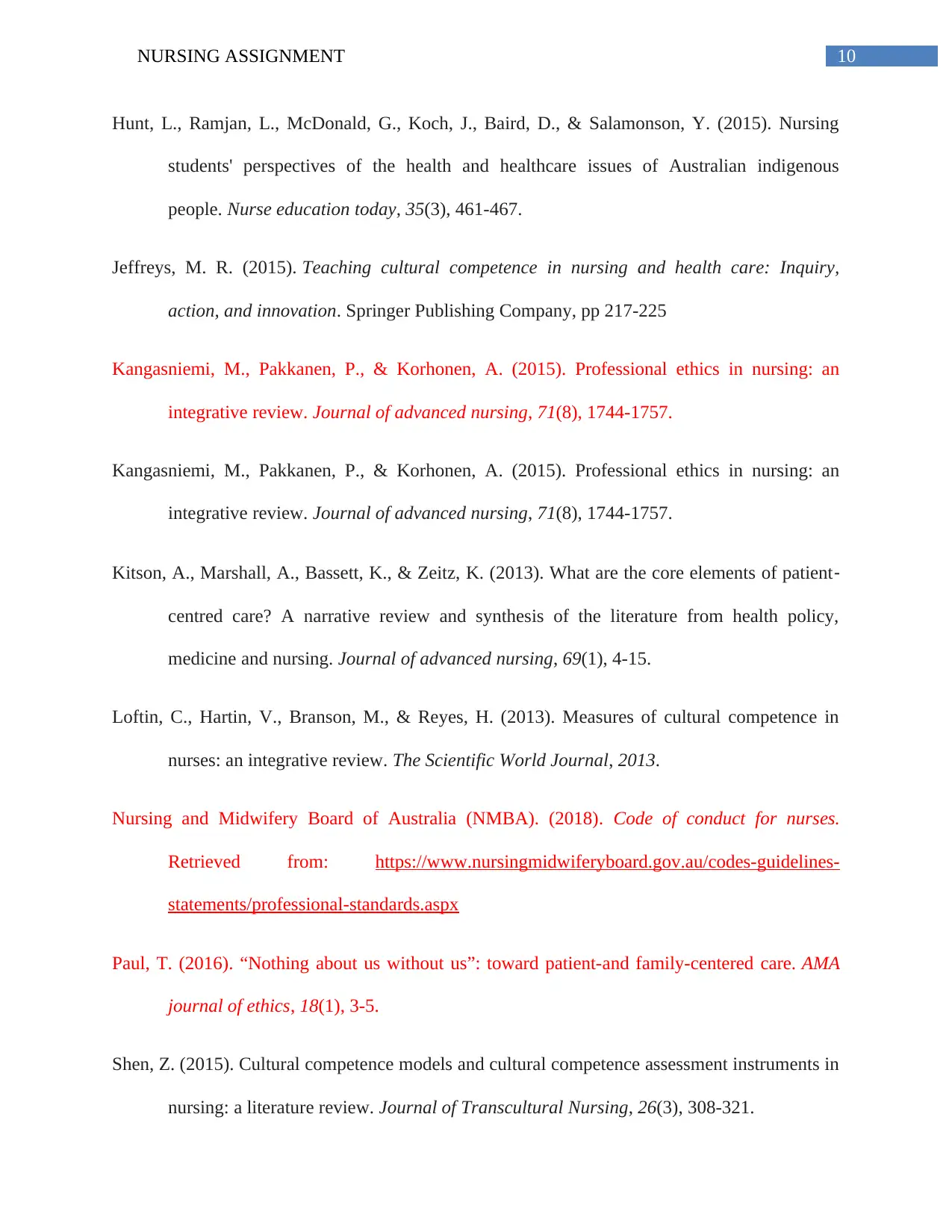
10NURSING ASSIGNMENT
Hunt, L., Ramjan, L., McDonald, G., Koch, J., Baird, D., & Salamonson, Y. (2015). Nursing
students' perspectives of the health and healthcare issues of Australian indigenous
people. Nurse education today, 35(3), 461-467.
Jeffreys, M. R. (2015). Teaching cultural competence in nursing and health care: Inquiry,
action, and innovation. Springer Publishing Company, pp 217-225
Kangasniemi, M., Pakkanen, P., & Korhonen, A. (2015). Professional ethics in nursing: an
integrative review. Journal of advanced nursing, 71(8), 1744-1757.
Kangasniemi, M., Pakkanen, P., & Korhonen, A. (2015). Professional ethics in nursing: an
integrative review. Journal of advanced nursing, 71(8), 1744-1757.
Kitson, A., Marshall, A., Bassett, K., & Zeitz, K. (2013). What are the core elements of patient‐
centred care? A narrative review and synthesis of the literature from health policy,
medicine and nursing. Journal of advanced nursing, 69(1), 4-15.
Loftin, C., Hartin, V., Branson, M., & Reyes, H. (2013). Measures of cultural competence in
nurses: an integrative review. The Scientific World Journal, 2013.
Nursing and Midwifery Board of Australia (NMBA). (2018). Code of conduct for nurses.
Retrieved from: https://www.nursingmidwiferyboard.gov.au/codes-guidelines-
statements/professional-standards.aspx
Paul, T. (2016). “Nothing about us without us”: toward patient-and family-centered care. AMA
journal of ethics, 18(1), 3-5.
Shen, Z. (2015). Cultural competence models and cultural competence assessment instruments in
nursing: a literature review. Journal of Transcultural Nursing, 26(3), 308-321.
Hunt, L., Ramjan, L., McDonald, G., Koch, J., Baird, D., & Salamonson, Y. (2015). Nursing
students' perspectives of the health and healthcare issues of Australian indigenous
people. Nurse education today, 35(3), 461-467.
Jeffreys, M. R. (2015). Teaching cultural competence in nursing and health care: Inquiry,
action, and innovation. Springer Publishing Company, pp 217-225
Kangasniemi, M., Pakkanen, P., & Korhonen, A. (2015). Professional ethics in nursing: an
integrative review. Journal of advanced nursing, 71(8), 1744-1757.
Kangasniemi, M., Pakkanen, P., & Korhonen, A. (2015). Professional ethics in nursing: an
integrative review. Journal of advanced nursing, 71(8), 1744-1757.
Kitson, A., Marshall, A., Bassett, K., & Zeitz, K. (2013). What are the core elements of patient‐
centred care? A narrative review and synthesis of the literature from health policy,
medicine and nursing. Journal of advanced nursing, 69(1), 4-15.
Loftin, C., Hartin, V., Branson, M., & Reyes, H. (2013). Measures of cultural competence in
nurses: an integrative review. The Scientific World Journal, 2013.
Nursing and Midwifery Board of Australia (NMBA). (2018). Code of conduct for nurses.
Retrieved from: https://www.nursingmidwiferyboard.gov.au/codes-guidelines-
statements/professional-standards.aspx
Paul, T. (2016). “Nothing about us without us”: toward patient-and family-centered care. AMA
journal of ethics, 18(1), 3-5.
Shen, Z. (2015). Cultural competence models and cultural competence assessment instruments in
nursing: a literature review. Journal of Transcultural Nursing, 26(3), 308-321.
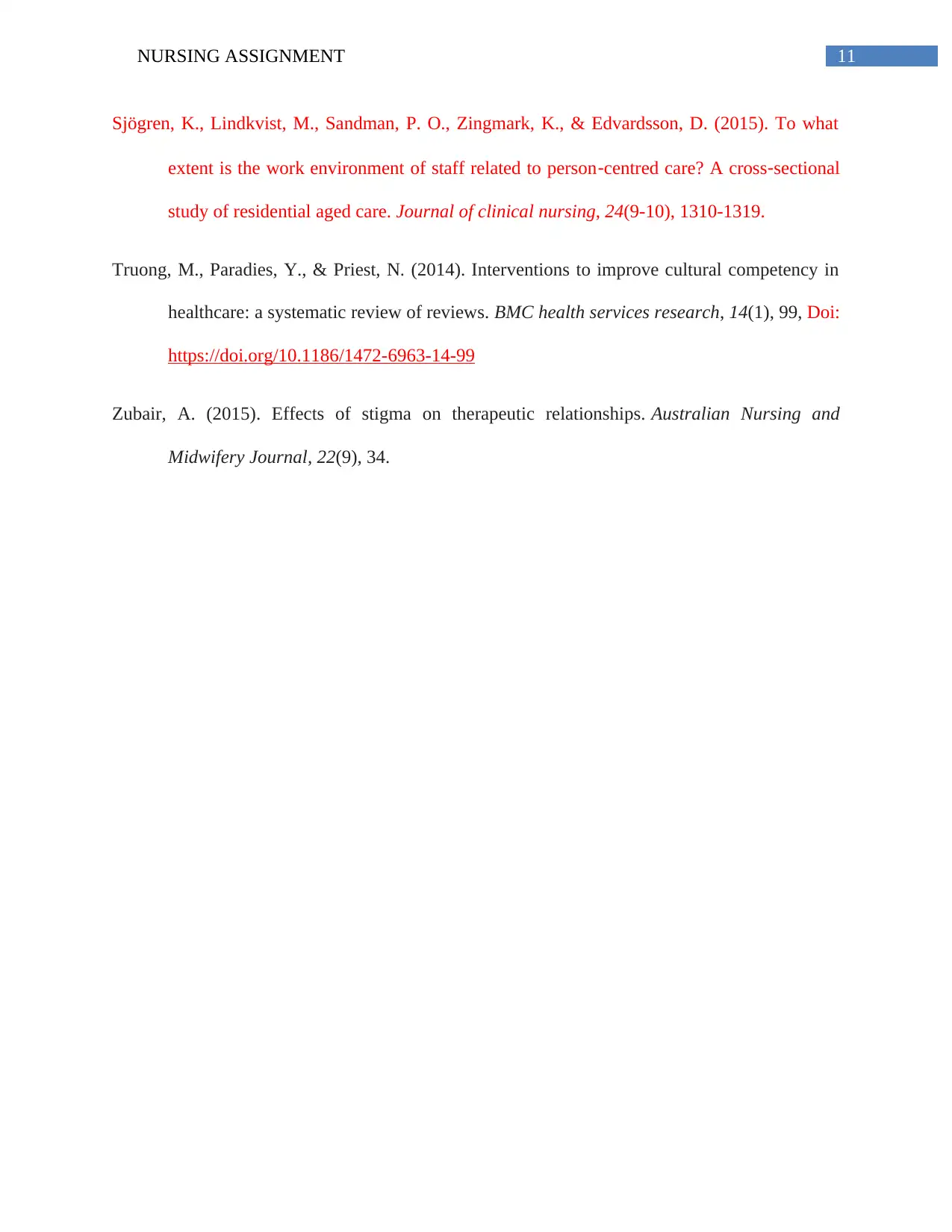
11NURSING ASSIGNMENT
Sjögren, K., Lindkvist, M., Sandman, P. O., Zingmark, K., & Edvardsson, D. (2015). To what
extent is the work environment of staff related to person‐centred care? A cross‐sectional
study of residential aged care. Journal of clinical nursing, 24(9-10), 1310-1319.
Truong, M., Paradies, Y., & Priest, N. (2014). Interventions to improve cultural competency in
healthcare: a systematic review of reviews. BMC health services research, 14(1), 99, Doi:
https://doi.org/10.1186/1472-6963-14-99
Zubair, A. (2015). Effects of stigma on therapeutic relationships. Australian Nursing and
Midwifery Journal, 22(9), 34.
Sjögren, K., Lindkvist, M., Sandman, P. O., Zingmark, K., & Edvardsson, D. (2015). To what
extent is the work environment of staff related to person‐centred care? A cross‐sectional
study of residential aged care. Journal of clinical nursing, 24(9-10), 1310-1319.
Truong, M., Paradies, Y., & Priest, N. (2014). Interventions to improve cultural competency in
healthcare: a systematic review of reviews. BMC health services research, 14(1), 99, Doi:
https://doi.org/10.1186/1472-6963-14-99
Zubair, A. (2015). Effects of stigma on therapeutic relationships. Australian Nursing and
Midwifery Journal, 22(9), 34.
⊘ This is a preview!⊘
Do you want full access?
Subscribe today to unlock all pages.

Trusted by 1+ million students worldwide
1 out of 12
Related Documents
Your All-in-One AI-Powered Toolkit for Academic Success.
+13062052269
info@desklib.com
Available 24*7 on WhatsApp / Email
![[object Object]](/_next/static/media/star-bottom.7253800d.svg)
Unlock your academic potential
Copyright © 2020–2025 A2Z Services. All Rights Reserved. Developed and managed by ZUCOL.





